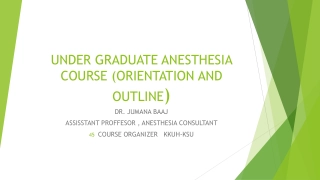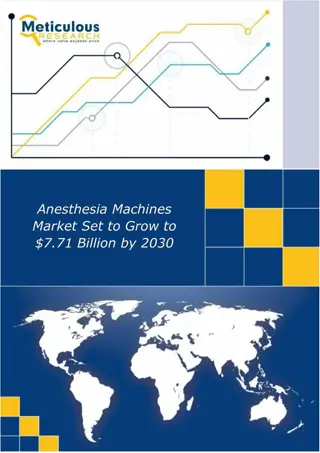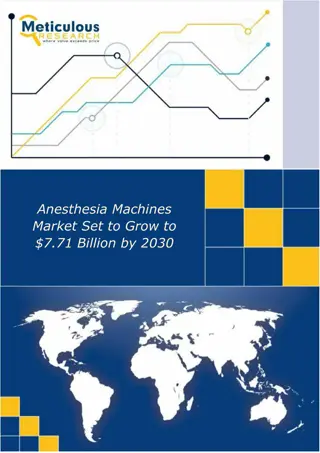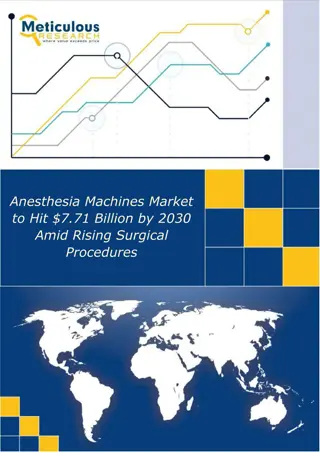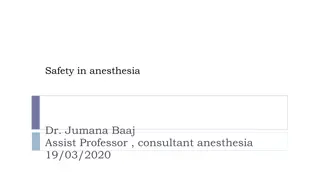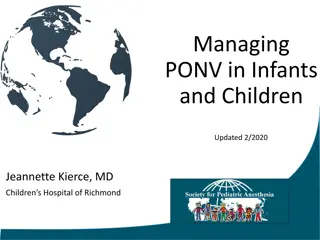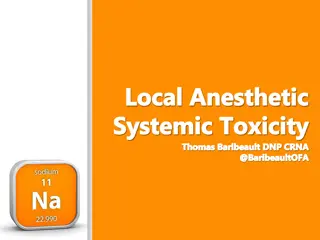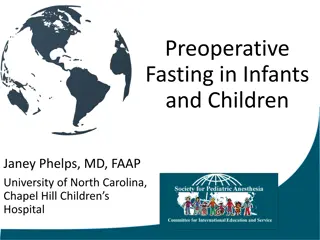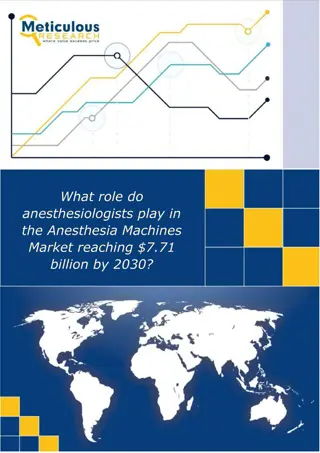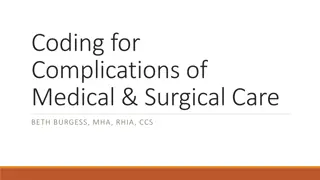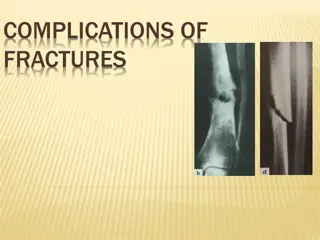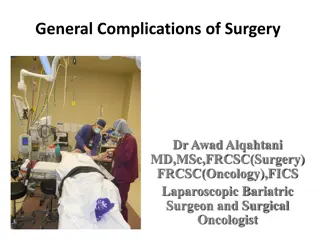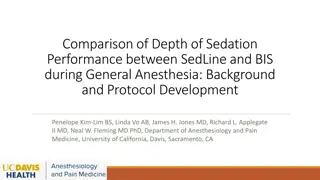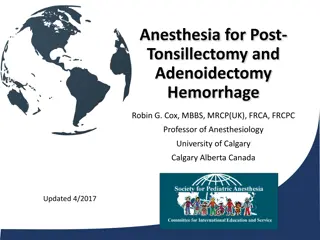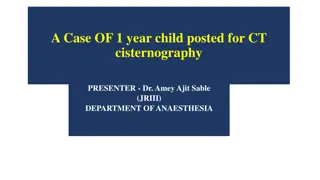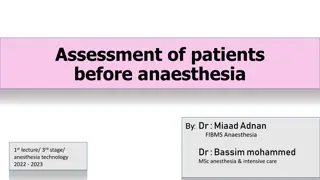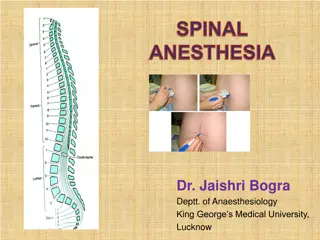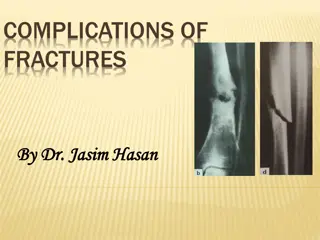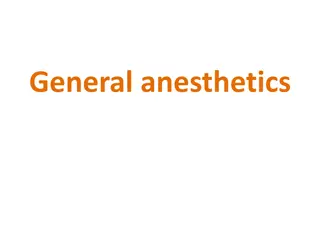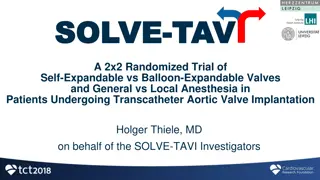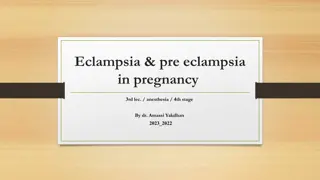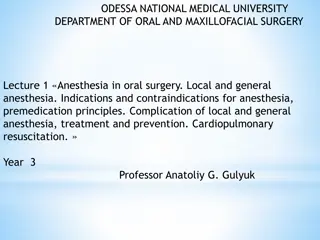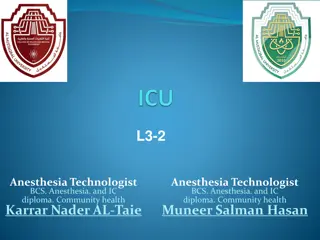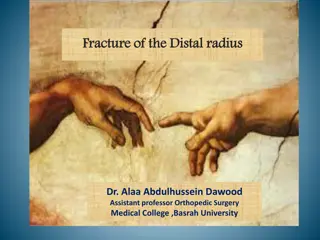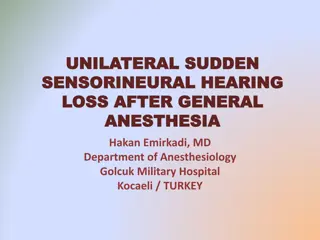Undergraduate Anesthesia Course Orientation
Guide for 4th-year medical students in Anesthesia Electives course, offering structured approach for learning anesthesia basics. Course provides consistent learning experience covering various aspects of anesthesia practice.
1 views • 39 slides
Anesthesia and Perioperative Care - Comprehensive Guide by Dr. Rajesh Raman
This detailed guide by Dr. Rajesh Raman covers various aspects of anesthesia and perioperative care, including preoperative assessment and optimization, intraoperative care, postoperative care, perioperative risk assessment, risk due to surgery, medication management, and routine investigations for
2 views • 31 slides
Anesthesia Machines Market Projected to Reach $7.71 Billion by 2030
Anesthesia Machines Market by Offering (Anesthesia Workstation, Delivery Systems, Portable, Monitor, Ventilator, Circuit, Mask, Vaporizer), Application (Orthopedic, Neurology, Cardiology, Urology), End User (Hospital, Clinic, ASC) - Global Forecast to 2030\n
0 views • 5 slides
Anesthesia And Perioperative Care
This detailed guide covers key aspects of anesthesia and perioperative care, emphasizing preoperative assessment, optimization, intraoperative management, and postoperative care. Topics include perioperative risk assessment, risk scoring, routine investigations, and medication management strategies
1 views • 31 slides
Anesthesia Machines Market Set to Grow to $7.71 Billion by 2030
The global anesthesia machines market is poised for substantial growth, projected to reach a remarkable $7.71 billion by 2030.\n
0 views • 4 slides
Anesthesia Machines Market
Delve into the $7.71 billion Anesthesia Machines Market: Gain exclusive insights into essential market trends, segments, geographical analysis, and competitive landscape.\n
0 views • 4 slides
Anesthesia Machines Market
The Anesthesia Machines Market is expected to reach $7.71 billion by 2030, growing at a compound annual growth rate (CAGR) of 7.5% from 2023 to 2030.\n
0 views • 4 slides
Anesthesia and Perioperative Care by Dr. Rajesh Raman
This informative content covers various aspects of anesthesia and perioperative care including preoperative assessment, optimization, intraoperative and postoperative care, perioperative risk assessment, risk due to surgery, risk scores for major cardiac events, routine investigations for patients,
0 views • 31 slides
France Anesthesia Devices Market
The France Anesthesia Devices Market is anticipated to exceed USD 1.45 billion by 2033, growing at a CAGR of 6.96% from 2023 to 2033.\n
0 views • 4 slides
Understanding Safety in Anesthesia Practice
Anesthesia carries inherent risks, making it a high-risk specialty in medicine. This presentation by Dr. Jumana Baaj delves into the complexities of anesthesia practice, highlighting the risks of complications, implementing safety measures in the operating room, and addressing common errors to enhan
0 views • 49 slides
Managing Postoperative Nausea and Vomiting in Infants and Children
Postoperative nausea and vomiting (PONV) is a significant concern in pediatric patients due to their increased risk compared to adults. This presentation by Dr. Jeannette Kierce covers the pathophysiology, risk factors, prophylaxis, and rescue treatments for PONV in infants and children, emphasizing
0 views • 34 slides
Understanding Local Anesthetic Systemic Toxicity in Anesthesia Practice
Local anesthetics are crucial in anesthesia for their ability to prevent nerve depolarization, but systemic toxicity can lead to serious complications. Last Causes, signs, and max dosage discussion along with the importance of recognizing early signs like lightheadedness, tinnitus, and late symptoms
0 views • 19 slides
Preoperative Fasting in Infants and Children: Guidelines and History
Explore the evolution and rationale behind preoperative fasting guidelines in infants and children, including historical cases of aspiration during anesthesia. Learn about Mendelson Syndrome, recommendations for aspiration prevention, and the development of NPO orders over the years. Discover the im
0 views • 26 slides
Anesthesia Machines Market
The Anesthesia Machines Market is expected to achieve a valuation of $7.71 billion by 2030, growing at a compound annual growth rate (CAGR) of 7.5% from 2023 to 2030. Anesthesia machines play a critical role in administering precise anesthesia during
0 views • 4 slides
Guidelines for Coding Complications of Medical & Surgical Care
Proper documentation and coding of complications of medical and surgical care are essential for accurate classification and billing. Assigning codes based on the provider's documentation of the relationship between the condition and care is crucial. Complications must be clearly documented with a ca
1 views • 55 slides
Complications of Fractures: Types and Consequences
Fractures can lead to a variety of complications, both locally and generally. General complications include shock, embolisms, crush syndrome, and more. Local complications can involve visceral, vascular, nerve injuries, compartment syndrome, infections, and more. Late complications may result in del
0 views • 29 slides
Anesthesia Billing & Reimbursement Basics
Understanding the essentials of anesthesia billing for surgical procedures is crucial for healthcare providers. This guide covers the key aspects such as the three fees generated by each procedure, calculation of total units, base units, time units, and the anesthesia fee calculation process. Knowin
4 views • 29 slides
Insights on Airway Management in Anesthesia Practices
General anesthesia procedures in the UK NHS involve approximately 2.9 million cases annually, with airway management being a critical aspect. Poor airway assessment and planning, lack of strategies for difficult airways, reluctance to use awake fibreoptic intubation, and inappropriate use of supragl
0 views • 27 slides
Surgical Complications and Pre-Operative Preparations by Dr. Awad Alqahtani
Dr. Awad Alqahtani, an experienced surgeon, discusses the general complications of surgery, pre-and post-operative care, pre-operative preparation, patient confirmation, anesthesia choices, surgical positioning, types of injuries, and classification of post-operative complications. Covering topics l
0 views • 17 slides
Comparison of SedLine and BIS Depth of Sedation Performance in General Anesthesia
This study evaluates the performance of SedLine and BIS monitoring devices in measuring anesthetic depth during general anesthesia. The research protocol aims to compare processed EEG indices from both monitors across various levels of anesthetic depth using a custom interface box. Inclusion criteri
0 views • 10 slides
Anesthesia Management for Post-Tonsillectomy Hemorrhage in Children
This article discusses the epidemiology, causes, and anesthesia management of post-tonsillectomy and adenoidectomy hemorrhage in children. It covers the rates of hemorrhage following these procedures, including primary and secondary occurrences, mortality statistics, and specific factors contributin
0 views • 31 slides
Case Study: 1-Year-Old Child Undergoing CT Cisternography for Head Injury Evaluation
A 1-year-old female child presented with a history of head injury and rhinorrhea. No other significant symptoms were observed, and the child was deemed stable for CT cisternography under general anesthesia. Normal systemic and general examination findings were noted, and standard anesthesia monitori
0 views • 22 slides
Understanding Hyperemesis Gravidarum: Symptoms, Complications, and Management
Hyperemesis gravidarum is a severe condition in pregnancy characterized by intractable nausea and vomiting, resulting in fluid and electrolyte imbalances, nutritional disturbances, and physical and psychological debilitation. The exact cause is unknown, but factors like hormonal changes, genetics, a
0 views • 22 slides
Preoperative Assessment of Patients for Anesthesia: Guidelines and Protocols
Efficient preoperative assessment is crucial to ensure patient safety and optimal outcomes during anesthesia administration. This process involves thorough history taking, physical examination, evaluation of medical conditions, and planning for anesthesia techniques. The assessment helps in identify
0 views • 46 slides
An Overview of Spinal Anesthesia in Regional Anesthesia Practice
Regional anesthesia, specifically spinal anesthesia, is a valuable technique involving the application of local anesthetic around a nerve to reduce or prevent impulse transmission. This method offers numerous advantages, such as cost-effectiveness, respiratory support, and post-operative pain relief
0 views • 46 slides
Complications of Fractures: Types and Risks
Complications of fractures can be classified as general, local early, and late complications. General complications include shock, embolisms, and fever while local complications involve injuries to nearby tissues and infections. Early local complications can lead to visceral, vascular, nerve injurie
0 views • 29 slides
Complications of Fractures and Their Management by Dr. Jasim Hasan
This detailed presentation by Dr. Jasim Hasan covers the complications of fractures, including general and local complications, early and late complications, and specific issues such as shock, vascular injuries, nerve damage, and more. The information highlights the importance of recognizing and add
0 views • 29 slides
Understanding General Anesthetics and Anesthesia
General anesthesia induces a reversible state of CNS depression, providing sedation, amnesia, muscle relaxation, reflex suppression, and analgesia. Preanesthetic medications prepare patients for the process, including antiemetics and anticholinergics. Anesthetics are delivered via inhalation or intr
0 views • 42 slides
Comparison of Valve Types and Anesthesia Strategies in Transcatheter Aortic Valve Implantation
In the SOLVE-TAVI trial, patients undergoing transcatheter aortic valve implantation were randomized to receive either self-expandable or balloon-expandable valves under general or local anesthesia. The study aims to compare the effectiveness and safety of different valve types and anesthesia approa
0 views • 27 slides
Complications One Year After Mid-Urethral Slings in Sweden
This study aims to provide a quantitative analysis of patient-reported complications one year after mid-urethral slings in Sweden. The GynOp register covers all Swedish surgeries with a high coverage and patient response rate. The study, led by Stefan Zacharias and Eva Uustal, looks into complicatio
0 views • 17 slides
Management of Eclampsia and Pre-eclampsia in Pregnancy: Anesthesia Considerations by Dr. Amassi Yakdhan
This comprehensive guide covers the management of hypertension terms in pregnancy, including chronic hypertension, gestational hypertension, pre-eclampsia, and eclampsia. It discusses the risks associated with high blood pressure during pregnancy and the potential complications such as multi-organic
0 views • 12 slides
Insights on Patient Experiences of Anesthesia Awareness: NAP5 National Audit Project
This study from the 5th National Audit Project (NAP5) delves into patient experiences of Anesthesia Awareness with General Anesthesia (AAGA). It highlights that not all AAGA instances are remembered, even with light sedation. The project explores the factors influencing memory during anesthesia, suc
0 views • 21 slides
Overview of Anesthesia in Oral Surgery: Local and General Anesthesia
Anesthesia in oral surgery involves local and general anesthesia, with discussions on indications, contraindications, premedication principles, complications, treatment, prevention, and cardiopulmonary resuscitation. The history of anesthesia in dentistry, from the use of cocaine in 1879 to the deve
0 views • 84 slides
Understanding Mechanical Ventilation in Anesthesia Practice
Anesthesia technologists play a crucial role in managing artificial ventilation, including concepts like Invasive Positive Mechanical Ventilation (IPMV), Fraction of Inspired Oxygen (FIO2), Tidal Volume (VT), Peak Flow Rate, Respiratory Rate, Minute Volume (VE), I:E Ratio, and more. They monitor and
0 views • 27 slides
Anesthesia and Upper Respiratory Tract Infections in Children
This presentation discusses the etiology, differential diagnoses, and management of upper respiratory tract infections (URIs) in children undergoing anesthesia. It covers causes of bronchoconstriction, adverse respiratory effects of URIs, and current anesthetic recommendations. The content emphasize
0 views • 52 slides
Common Complications of Exodontia in Dental Practice
Undesirable situations can arise during dental exodontia, including perioperative and postoperative complications. Perioperative complications may include crown fractures, soft tissue injuries, and failure to obtain anesthesia, while postoperative complications can involve trismus, hematoma, and wou
0 views • 48 slides
Understanding Fluid Bolus in Anesthesia Management
Anesthesia providers often face challenges like hypotension during procedures. In such cases, increasing fluids can help expand blood volume temporarily. However, it is crucial to calculate the amount of fluid accurately to prevent complications like albumin washout, which can lead to further issues
0 views • 14 slides
Awake vs. Deep Extubation: An Anesthesia Comparison
Explore the differences between awake and deep extubation techniques in anesthesia practice, including learning objectives, stages of anesthesia, safe execution, risks, benefits, appropriate candidates, and management of airway complications. Understand the criteria for awake extubation and indicati
0 views • 22 slides
Distal Radius Fracture: Diagnosis, Management, and Complications
Distal radius fractures, particularly Colles fractures, are common injuries, often affecting elderly women due to osteoporosis. These fractures typically result from a fall onto an outstretched hand, causing dorsal and sometimes radial displacement of the distal radius fragment. Clinical features in
0 views • 32 slides
Unilateral Sudden Sensorineural Hearing Loss After General Anesthesia: A Case Report
A 36-year-old female experienced a sudden sensorineural hearing loss of 30 dB or more in at least three consequent audiometric frequencies following general anesthesia for lipoma excision. This case highlights the importance of thorough diagnosis, including ruling out potential ototoxic drugs and un
0 views • 22 slides
